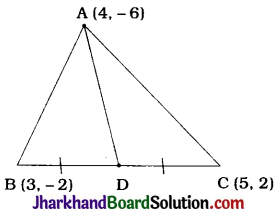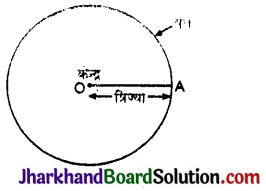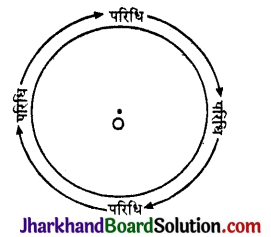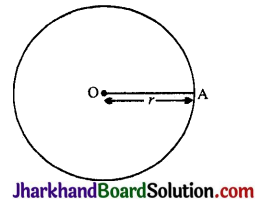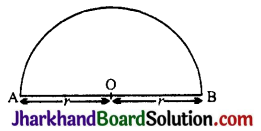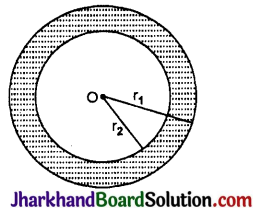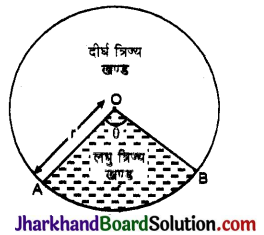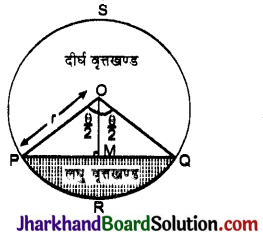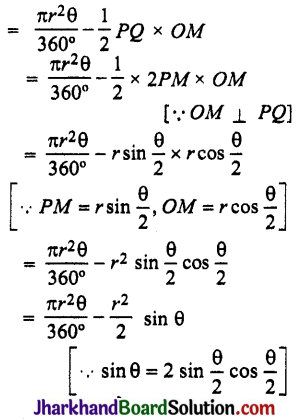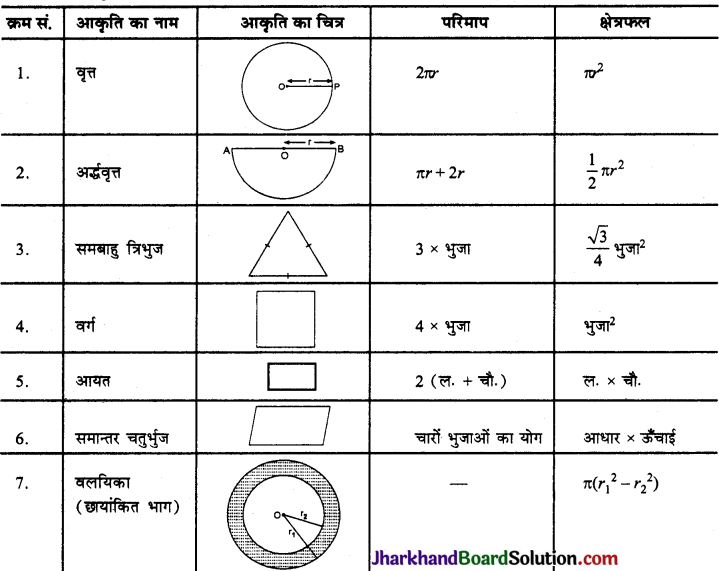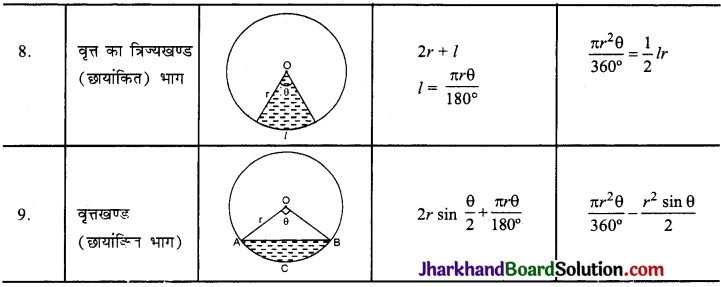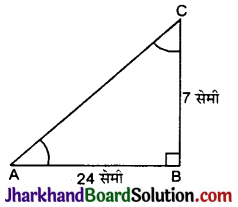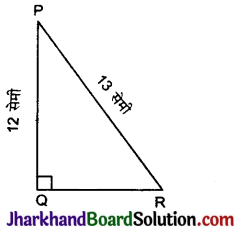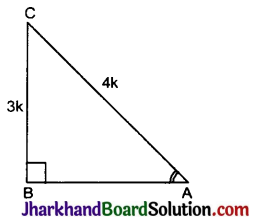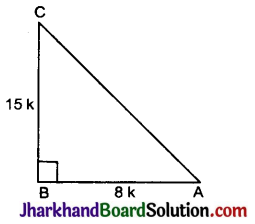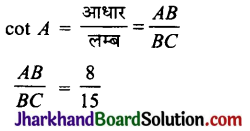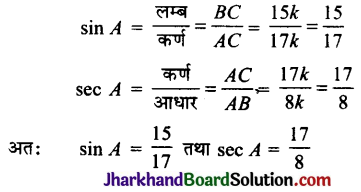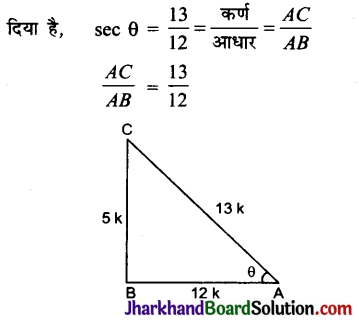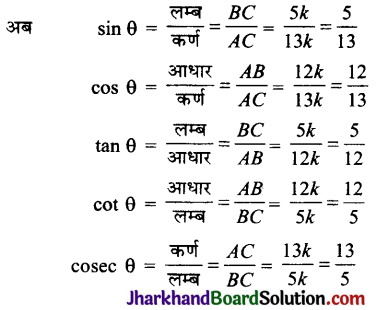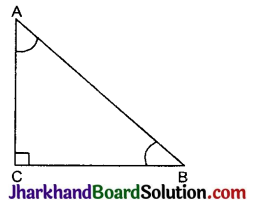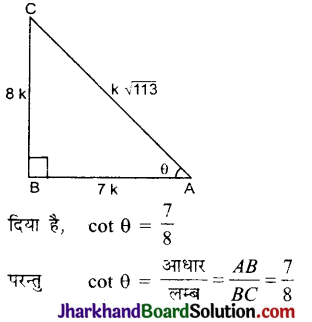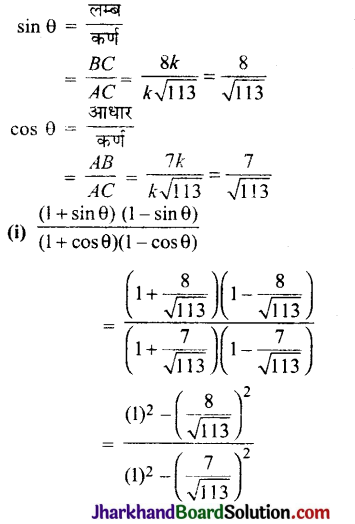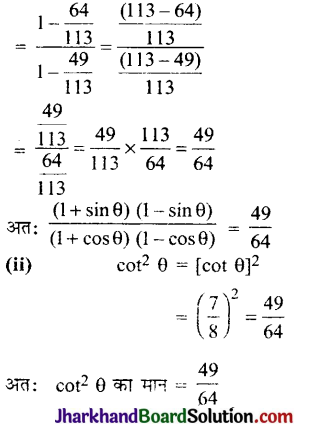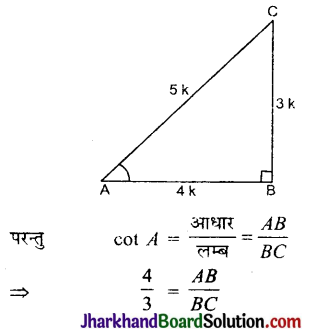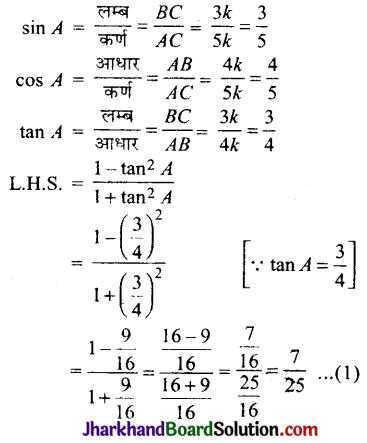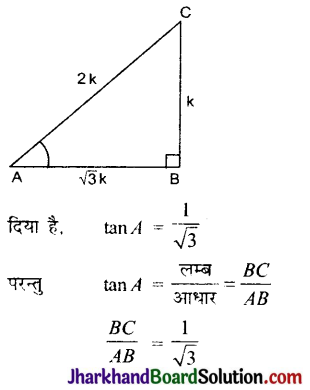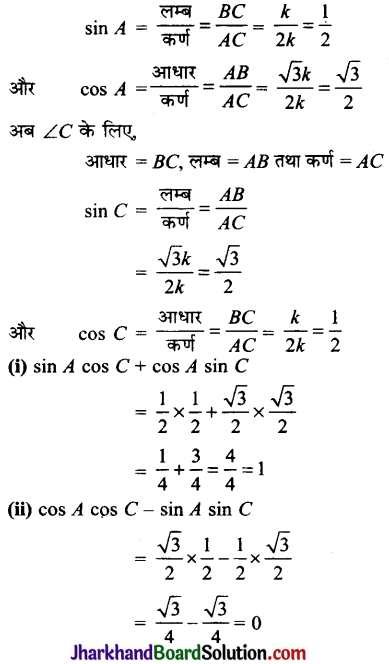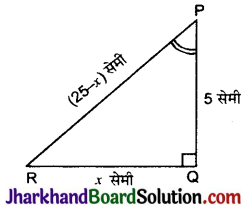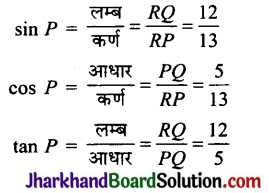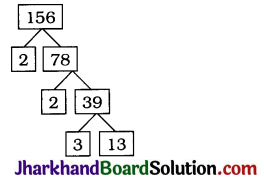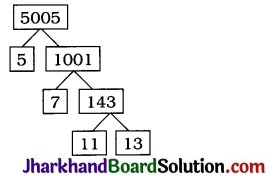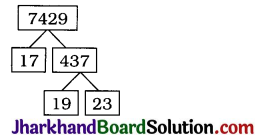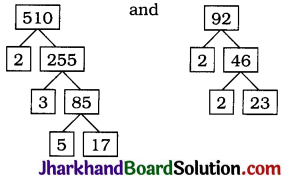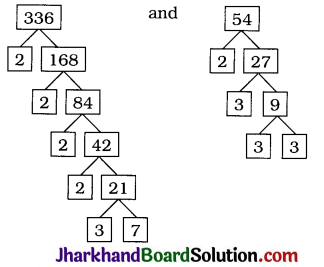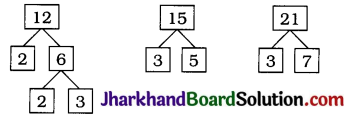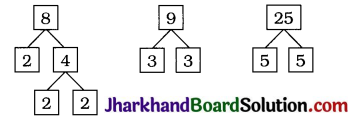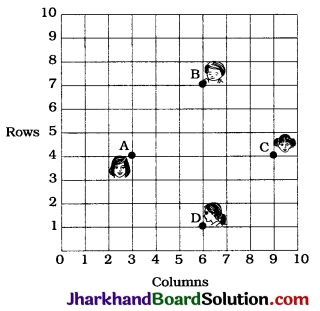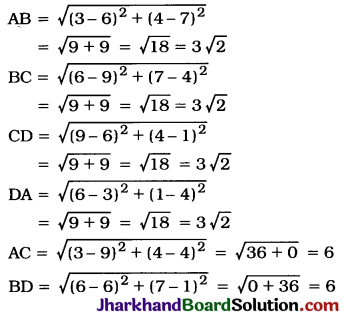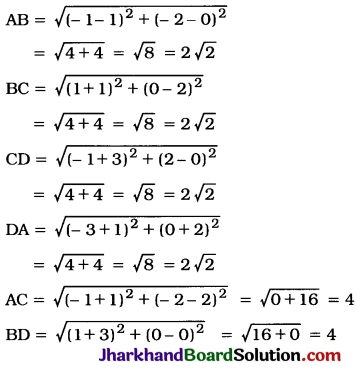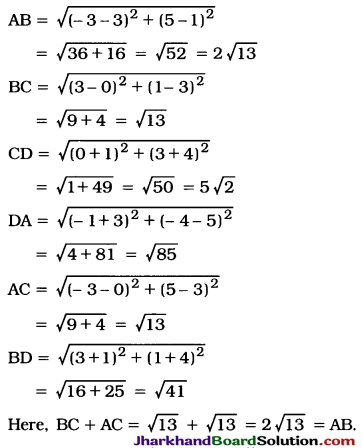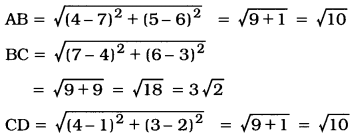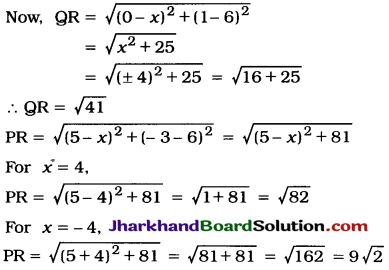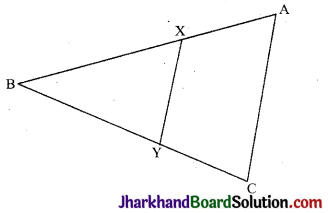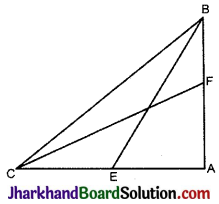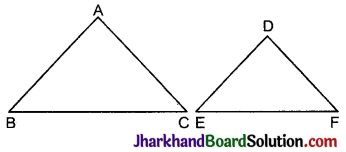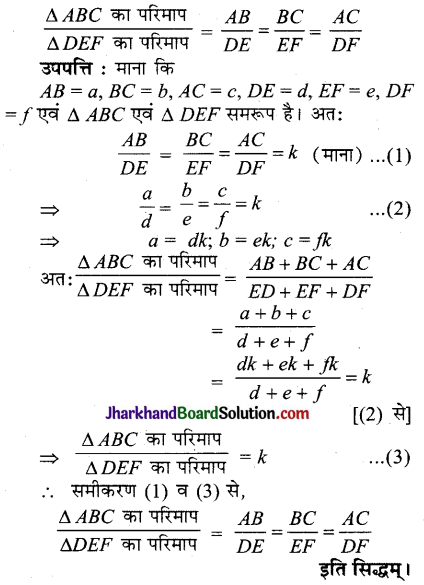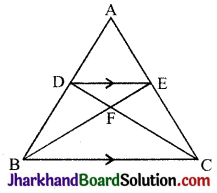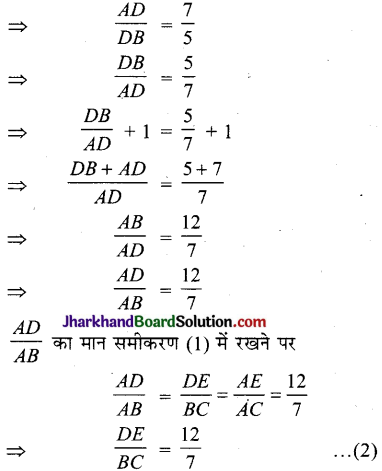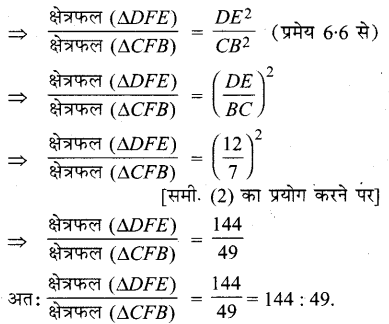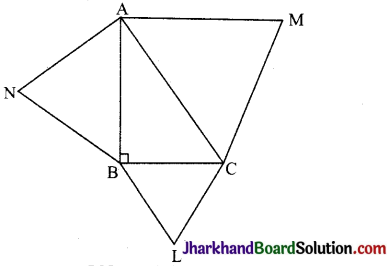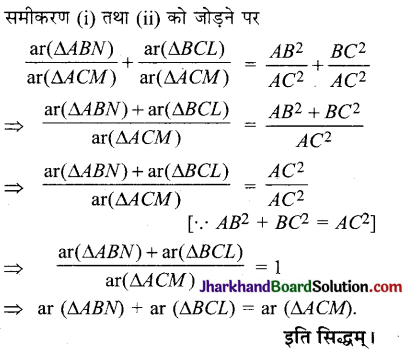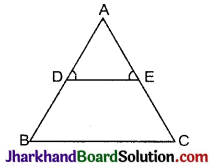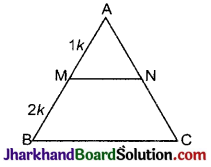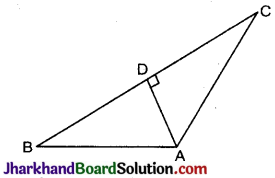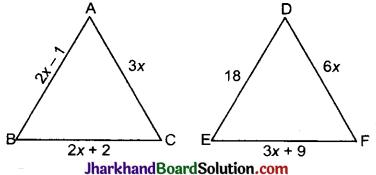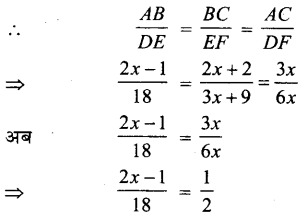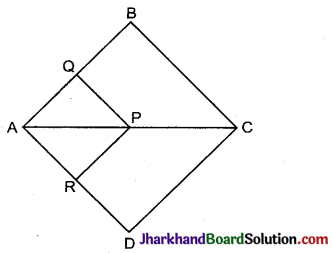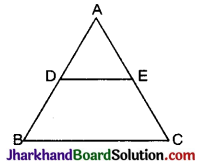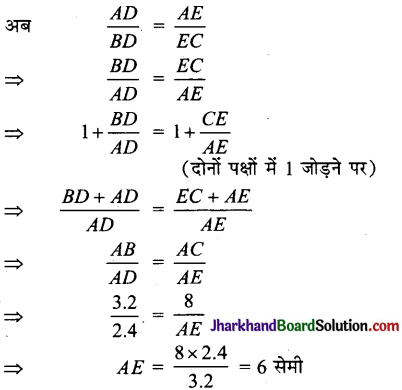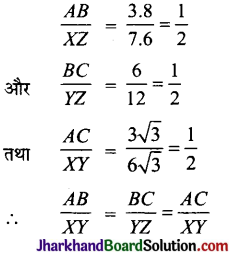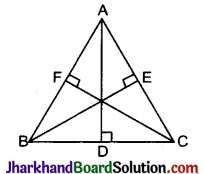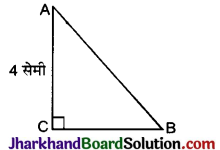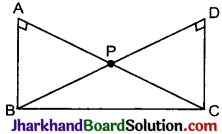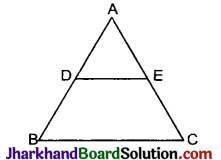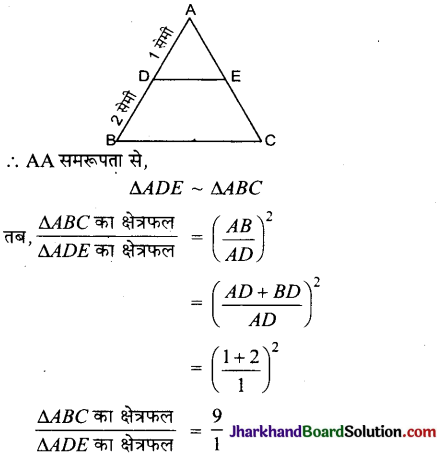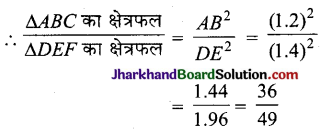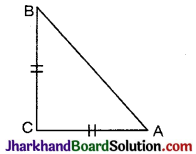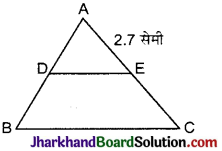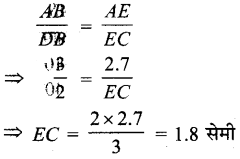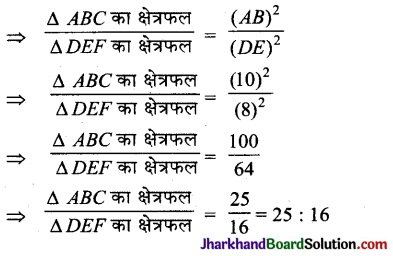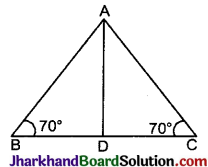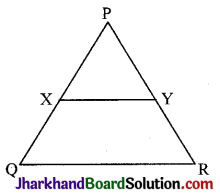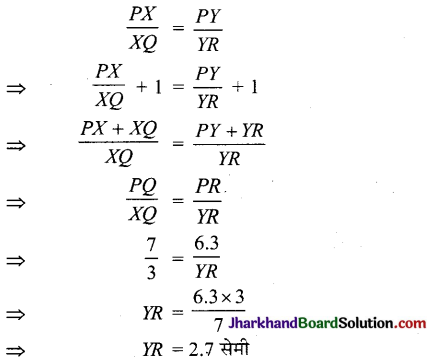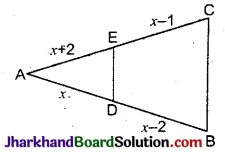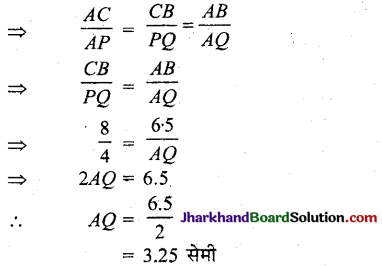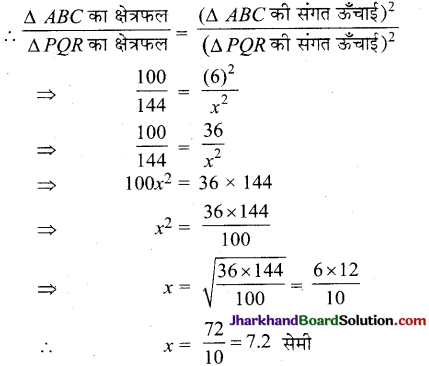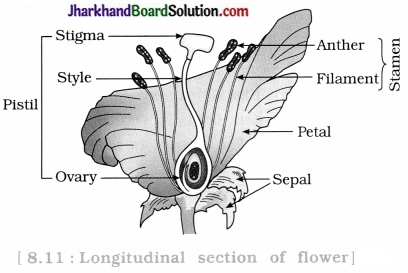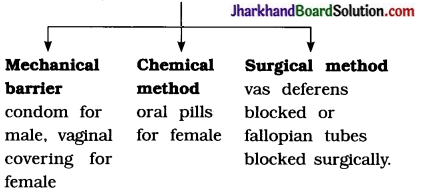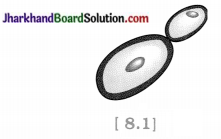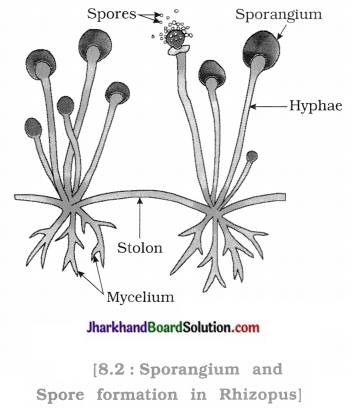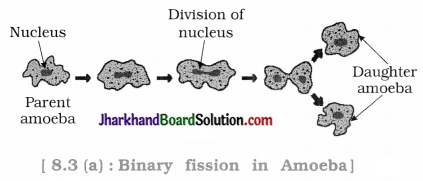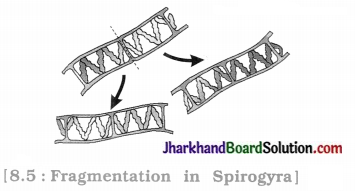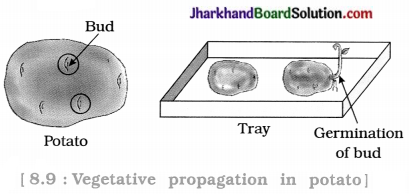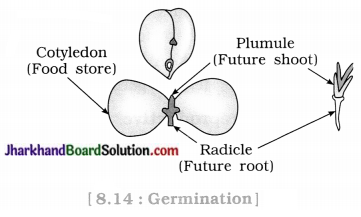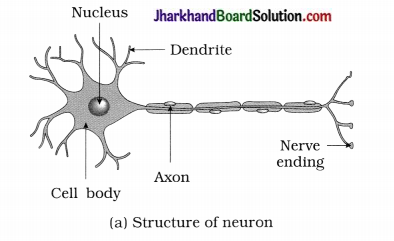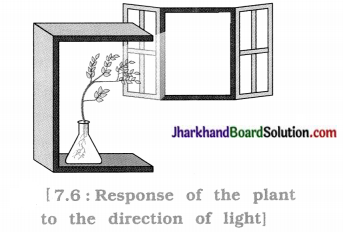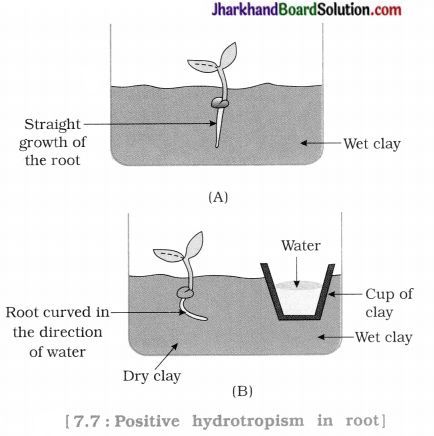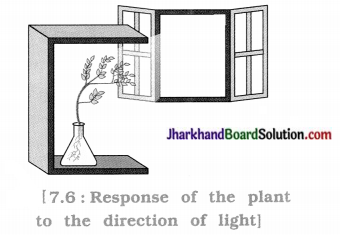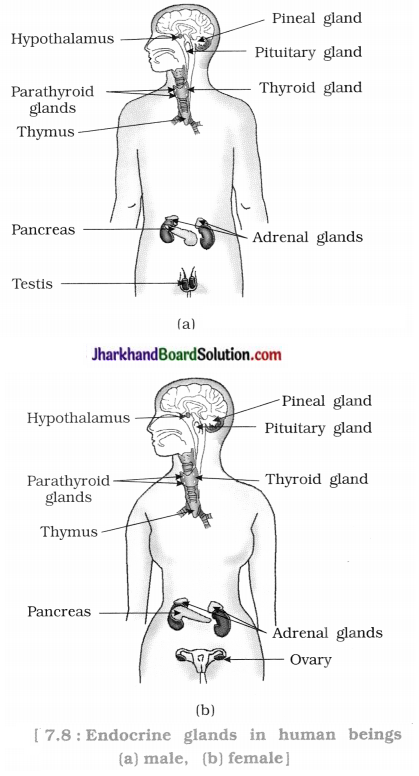Jharkhand Board JAC Class 10 Science Solutions Chapter 10 प्रकाश-परावर्तन तथा अपवर्तन Textbook Exercise Questions and Answers.
JAC Board Class 10 Science Solutions Chapter 10 प्रकाश-परावर्तन तथा अपवर्तन
Jharkhand Board Class 10 Science प्रकाश-परावर्तन तथा अपवर्तन Textbook Questions and Answers
अभ्यास प्रश्न (पृष्ठ संख्या-204-206)
1. निम्न में से कौन-सा पदार्थ लेंस बनाने के लिए प्रयुक्त नहीं किया जा सकता?
(a) जल
(b) काँच
(c) प्लास्टिक
(d) मिट्टी
उत्तर:
(d) मिट्टी।
2. किसी बिंब का अवतल दर्पण द्वारा बना प्रतिबिंब आभासी, सीधा तथा बिंब से बड़ा पाया गया। वस्तु की स्थिति कहाँ होनी चाहिए?
(a) मुख्य फोकस तथा वक्रता केन्द्र के बीच
(b) वक्रता केन्द्र पर
(c) वक्रता केन्द्र से परे
(d) दर्पण के ध्रुव तथा मुख्य फोकस के बीच
उत्तर:
(d) दर्पण के ध्रुव तथा मुख्य फोकस के बीच।
3. किसी बिंब का वास्तविक तथा समान साइज का प्रतिबिंब प्राप्त करने के लिए बिंब को उत्तल लेंस के सामने कहाँ रखें?
(a) लेंस के मुख्य फोकस पर
(b) फोकस दूरी की दोगुनी दूरी पर
(c) अनंत पर
(d) लेंस के प्रकाशिक केन्द्र तथा मुख्य फोकस के बीच
उत्तर:
(b) फोकस दूरी की दोगुनी दूरी पर।
4. किसी गोलीय दर्पण तथा किसी पतले गोलीय लेंस दोनों की फोकस दूरियाँ 15 cm हैं। दर्पण तथा लेंस संभवत: हैं-
(a) दोनों अवतल
(b) दोनों उत्तल
(c) दर्पण अवतल तथा लेंस उत्तल
(d) दर्पण उत्तल तथा लेंस अवतल
उत्तर:
(a) दोनों अवतल।
5. किसी दर्पण से आप चाहे कितनी ही दूरी पर खड़े हों, आपका प्रतिबिंब सदैव सीधा प्रतीत होता है। संभवतः दर्पण है-
(a) केवल समतल
(b) केवल अवतल
(c) केवल उत्तल
(d) या तो समतल अथवा उत्तल
उत्तर:
(d) या तो समतल अथवा उत्तल
6. किसी शब्दकोश (Dictionary) में पाए गए छोटे अक्षरों को पढ़ते समय आप निम्न में से कौन-सा लेंस पसंद करेंगे?
(a) 50 cm फोकस दूरी का एक उत्तल लेंस
(b) 50 cm फोकस दूरी का एक अवतल लेंस
(c) 5 cm फोकस दूरी का एक उत्तल लेंस
(d) 5 cm फोकस दूरी का एक अवतल लेंस
उत्तर:
(c) 5 cm फोकस दूरी का एक उत्तल लेंस।

प्रश्न 7.
15 cm फोकस दूरी के एक अवतल दर्पण का उपयोग करके हम किसी बिंब का सीधा प्रतिबिंब बनाना चाहते हैं। बिंब ‘दर्पण से दूरी का परिसर (Range) क्या होना चाहिए? प्रतिबिंब की प्रकृति कैसी है? प्रतिबिंब बिंब से बड़ा है अथवा छोटा? इस स्थिति में प्रतिबिंब बनने का एक किरण आरेख बनाइए।
उत्तर:
बिंब का दर्पण से दूरी दर्पण के ध्रुव से 0 से 15 सेमी के बीच है (अर्थात्, 15 सेमी से कम है)।
- प्रतिबिंब की प्रकृति आभासी तथा सीधा
- प्रतिबिंब, बिंब से बड़ा है।
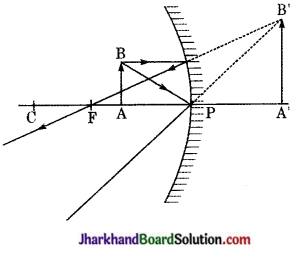
प्रश्न 8.
निम्न स्थितियों में प्रयुक्त दर्पण का प्रकार बताइए-
(a) किसी कार का अग्रदीप (हैडलाइट)
(b) किसी वाहन का पार्श्व / पश्च दृष्टि दर्पण
(c) सौर मट्टी
अपने उत्तर की कारण सहित पृष्टि कीजिए।
उत्तर:
(a) किसी कार के हैड लाइट में अवतल दर्पण का प्रयोग किया जाता है क्योंकि वह प्रकाश को परावर्तित कर सकता है।
(b) किसी वाहन के पार्श्व तथा पश्च दृश्य के लिए उत्तल दर्पण का प्रयोग किया जाता है क्योंकि यह वस्तु का सीधा प्रतिबिंब बनाता है और पीछे के ट्रैफिक के विस्तृत क्षेत्र को देख सकता है।
(c) सौर भट्टी में अवतल दर्पण का प्रयोग किया जाता है, क्योंकि दर्पण सूर्य की किरणों को वस्तु पर फोकस करके उसे ताप प्रदान करता है।
प्रश्न 9.
किसी उत्तल लेंस का आधा भाग काले कागज से ढक दिया गया है। क्या यह लेंस किसी बिंब का पूरा प्रतिबिंब बना पाएगा? अपने उत्तर की प्रयोग द्वारा जाँच कीजिए। अपने प्रेक्षणों की व्याख्या कीजिए।
उत्तर:
हाँ, उत्तल लेंस आधा भाग काले कागज से ढकने के बावजूद भी वस्तु का पूरा प्रतिबिंब बनाता है। चूँकि प्रकाश किरणें लेंस के आधा भाग वस्तु पर से गुजरती हैं और वस्तु का पूरा प्रतिबिंब बनाती हैं।
प्रश्न 10.
5 cm लंबा कोई बिंब 10 cm फोकस दूरी के किसी अभिसारी लेंस से 25. cm दूरी पर रखा जाता है। प्रकाश किरण आरेख खींचकर बनने वाले प्रतिबिंब की स्थिति, साइज तथा प्रकृति ज्ञात कीजिए। उत्तर:
वस्तु की लंबाई (h) = 5 cm
वस्तु की दूरी (u) = – 25 cm
फोकस दूरी (f) = + 10 cm
चूँकि \(\frac { 1 }{ v }\) – \(\frac { 1 }{ u }\) = \(\frac { 1 }{ f }\)
⇒ \(\frac{1}{v}=\frac{1}{u}+\frac{1}{f}\)
⇒ \(\frac{1}{v}=\frac{1}{-25}+\frac{1}{10}\)
⇒ \(\frac{1}{v}=\frac{-2+5}{50}=\frac{+3}{50}\)
⇒ v = + \(\frac { 50 }{ 3 }\)
= + 16.56 cm
v का धनात्मक चिन्ह यह दर्शाता है कि प्रतिबिंब लेंस के प्रकाशीय केन्द्र के दाई तरफ 16.67 cm की दूरी पर बनेगा। इसलिए प्रतिबिंब वास्तविक तथा उलटा बनेगा।
आवर्धन m = \(\frac{h_1}{h}=\frac{v}{u}\)
या h1 = h x \(\frac { v }{ u }\)
प्रतिबिंब का आकार

h1 का ऋणात्मक चिन्ह दर्शाता है कि प्रतिबिंब उलटा बनेगा। यह मुख्य अक्ष के नीचे बनेगा।
इस प्रकार, एक वास्तविक, उलटा प्रतिबिंब लेंस की दाईं तरफ 16.67 की दूरी पर 3\(\frac { 1 }{ 3 }\)cm लंबा बनेगा।
प्रश्न 11.
15 cm फोकस दूरी का कोई अवतल लेंस किसी बिंब का प्रतिबिंब लेंस से 10 cm दूरी पर बनाता है। बिंब लेंस से कितनी दूरी पर स्थित है? किरण आरेख खींचिए।
उत्तर:
फोकस दूरी f = 15 सेमी, प्रतिबिंब की दूरी v = – 10 सेमी, बिंब दूरी u = ?
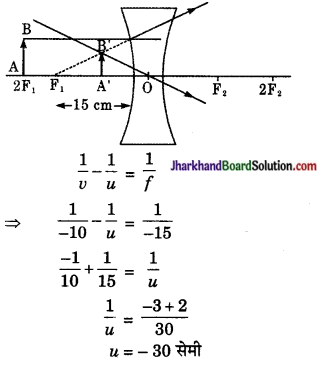
अर्थात्, बिंब अवतल लेंस से 30 सेमी की दूरी पर है।
प्रश्न 12.
15 cm फोकस दूरी के किसी उत्तल दर्पण से कोई बिंब 10 cm दूरी पर रखा है। प्रतिबिंब की स्थिति तथा प्रकृति ज्ञात कीजिए।
उत्तर:
फोकस दूरी f = 15 सेमी, बिंब की दूरी = – 10 सेमी, प्रतिबिंब दूरी v = ?
हम जानते हैं कि \(\frac{1}{u}+\frac{1}{v}=\frac{1}{f}\)
⇒ \(\frac{1}{-10}+\frac{1}{v}=\frac{1}{15}\)
\(\frac{1}{v}=\frac{1}{15}+\frac{1}{10}\)
\(\frac{1}{v}=\frac{2+3}{30}\)
\(\frac{1}{v}=\frac{5}{30}\)
v = 6 सेमी
अर्थात्, प्रतिबिंब दर्पण के पीछे 6 सेमी की दूरी पर बनता है। प्रतिबिंब वास्तविक तथा उलटा है।
प्रश्न 13.
एक समतल दर्पण द्वारा उत्पन्न आवर्धन + 1 है। इसका क्या अर्थ है?
उत्तर:
धनात्मक चिन्ह यह दर्शाता है कि प्रतिबिंब आभासी, सीधा तथा समान आकार का बना है।
प्रश्न 14.
5.0 सेमी लंबाई का कोई बिंब 30 सेमी वक्रता त्रिज्या के किसी उत्तल दर्पण के सामने 20 सेमी. दूरी पर रखा गया है। प्रतिबिंब की स्थिति, प्रकृति तथा साइज ज्ञात कीजिए।
उत्तर:
यहाँ, बिंब की ऊँचाई h1 = 5 सेमी,
वक्रता त्रिज्या R = 30 सेमी
\(\frac { R }{ 2 }\) = f
या फोकस दूरी f = \(\frac { 30 }{ 2 }\) = + 15 सेमी
बिंब दूरी u = – 20 सेमी
प्रतिबिंब की दूरी = ?
प्रतिबिंब की ऊँचाई h2 = ?
तो प्रतिबिंब की दूरी v = ?
प्रतिबिंब की ऊँचाई h2 = ?
हम जानते हैं कि \(\frac { 1 }{ v }\) + \(\frac { 1 }{ u }\) = \(\frac { 1 }{ f }\)
⇒ \(\frac { 1 }{ v }\) + \(\frac { 1 }{ -20 }\) = \(\frac { 1 }{ +15 }\)
\(\frac { 1 }{ v }\) = \(\frac { 1 }{ 15 }\) + \(\frac { 1 }{ 20 }\) = \(\frac { 4+3 }{ 60 }\)
v = \(\frac { 60 }{ 7 }\) सेमी = 8.57 सेमी
प्रतिबिंब दर्पण के पीछे 8.6 सेमी की दूरी पर बना है।
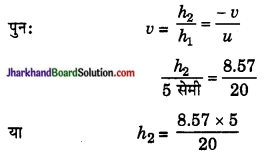
अर्थात्, प्रतिबिंब का आकार 2.175 (या 2.2 सेमी) है। प्रतिबिंब आभासी सीधा तथा छोटी है।
प्रश्न 15.
7.0 cm साइज का कोई बिंब 18 सेमी फोकस दूरी के अवतल दर्पण के सामने 27 सेमी दूरी पर रखा गया है। दर्पण से कितनी दूरी पर किसी परदे को रखें कि उस पर वस्तु का स्पष्ट फोकसित प्रतिबिंब प्राप्त किया जा सके। प्रतिबिंब का साइज तथा प्रकृति ज्ञात कीजिए।
उत्तर:
यहाँ, बिंब की ऊँचाई h1 = 5 सेमी,
बिंब दूरी u = – 27 सेमी,
फोकस दूरी f = – 18 सेमी,
तो प्रतिबिंब की दूरी v = ?
प्रतिबिंब की ऊँचाई h2 = ?
हम जानते हैं कि
\(\frac { 1 }{ v }\) + \(\frac { 1 }{ u }\) = \(\frac { 1 }{ f }\)
⇒ \(\frac { 1 }{ -27 }\) + \(\frac { 1 }{ v }\) = \(\frac { 1 }{ -18 }\)
\(\frac { 1 }{ v }\) = \(\frac { -1 }{ 18 }\) + \(\frac { 1 }{ 27 }\)
= \(\frac { -3+2 }{ 5 }\)
v = – 54 सेमी.
अर्थात्, परदे को दर्पण से 54 सेमी की दूरी पर रखी जानी चाहिए।
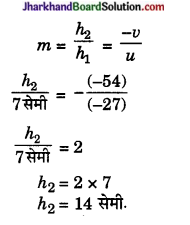
h2 = 14 सेमी.
अर्थात्, प्रतिबिंब की ऊँचाई 14 सेमी है तथा यह वास्तविक और उलटा है।

प्रश्न 16.
उस लेंस की फोकस दूरी ज्ञात कीजिए जिसकी क्षमता – 2.0D है। यह किस प्रकार का लेंस है?
उत्तर:
P = \(\frac { 1 }{ f }\)
– 20 = \(\frac { 1 }{ f }\)
f = \(\frac { -1 }{ 2 }\) मी
f = – \(\frac { 1 }{ 2 }\) x 100 मी
f = 50 मी = – 0.50 सेमी
अर्थात्, लेंस की फोकस दूरी 0.40 मी है तथा यह अवतल लेंस है।
प्रश्न 17.
कोई डॉक्टर + 1.5D क्षमता का संशोधक लेंस निर्धारित करता है। लेंस की फोकस दूरी ज्ञात कीजिए। क्या निर्धारित लेंस अभिसारी है अथवा अपसारी?
उत्तर:
P = \(\frac { 1 }{ f }\)
1.5 = \(\frac { 1 }{ f }\)
f = \(\frac { 1 }{ 1.5 }\) मी = \(\frac { 10 }{ 15 }\) मी
= \(\frac { 2 }{ 3 }\) मी = + 0.67 मी
अर्थात्, लेंस की फोकस दूरी + 0.67 मी है निर्धारित लेंस अभिसारी है।
Jharkhand Board Class 10 Science प्रकाश-परावर्तन तथा अपवर्तन InText Questions and Answers
पाठगत प्रश्न (पृष्ठ संख्या – 185 )
प्रश्न 1.
अवतल दर्पण के मुख्य फोकस की परिभाषा लिखिए।
उत्तर:
अवतल दर्पण पर मुख्य अक्ष के समांतर आपतित किरणें परावर्तित होकर दर्पण की मुख्य फोकस के जिस बिन्दु पर मिलती है प्रतिच्छेदी है, वह बिन्दु अवतल दर्पण का मुख्य फोकस कहलाता है।
प्रश्न 2.
एक गोलीय दर्पण की वक्रता त्रिज्या 20 सेमी है। इसकी फोकस दूरी क्या होगी?
उत्तर:
हम जानते हैं कि,
R = 2f
जहाँ, R = 20 सेमी
∴ f = \(\frac { 20 }{ 2 }\) = 10 सेमी
गोलीय दर्पण की फोकस दूरी = 10 सेमी
प्रश्न 3.
उस दर्पण का नाम बताइए जो बिंब का सीधा तथा आवर्धित प्रतिबिंब बना सके।
उत्तर:
अवतल दर्पण।
प्रश्न 4.
हम वाहनों में उत्तल दर्पण को पश्च-दृश्य दर्पण के रूप में वरीयता क्यों देते हैं?
उत्तर:
वाहनों में उत्तल दर्पण को पश्च- दृश्य दर्पण के रूप में वरीयता निम्न कारणों से देते हैं-
- यह सदैव सीधा एवं छोटा प्रतिबिंब बनाते हैं।
- इनका दृष्टि- क्षेत्र बहुत अधिक होता है क्योंकि ये बाहर की ओर वक्रित होते हैं।
अतः समतल दर्पण की तुलना में उत्तल दर्पण ड्राइवर को अपने पीछे के बहुत बड़े क्षेत्र को देखने में सक्षम बनाते हैं।
पाठगत प्रश्न (पृष्ठ संख्या-188)
प्रश्न 1.
उस उत्तल दर्पण की फोकस दूरी ज्ञात कीजिए जिसकी वक्रता त्रिज्या 32 cm है।
उत्तर:
उत्तल दर्पण की वक्रता त्रिज्या
R = 32 cm
अतः f = \(\frac { R }{ 2 }\) = \(\frac { 32 }{ 2 }\)
= 16 cm
अतः उत्तल दर्पण की फोकस दूरी 16 cm होगी।
प्रश्न 2.
कोई अवतल दर्पण अपने सामने 10 em दूरी पर रखे किसी बिंब का तीन गुणा आवर्धित (बड़ा) वास्तविक प्रतिबिंब बनाता है। प्रतिबिंब दर्पण से कितनी दूरी पर है?
उत्तर:
बिंब- दूरी u = – 10 cm
आवर्धन m = – 3 चूँकि प्रतिबिंब वास्तविक है।
m = – \(\frac { v }{ u }\)
⇒ – 3 = \(\frac { v }{ -10 }\)
∴ v = – 30 cm
अतः प्रतिबिंब दर्पण के सामने 30 cm की दूरी पर बनता है।
पाठगत प्रश्न (पृष्ठ संख्या – 194)
प्रश्न 1.
वायु में गमन करती प्रकाश की एक किरण जल में तिरछी प्रवेश करती है। क्या प्रकाश किरण अभिलंब की ओर झुकेगी अथवा अभिलंब से दूर हटेगी? बताइए क्यों?
उत्तर:
प्रकाश की किरण जब वायु से जल में गमन करती है तो यह अभिलंब की ओर झुकती है, क्योंकि जल, वायु की तुलना में सघन माध्यम है अर्थात् प्रकाश की किरणें विरल से सघन माध्यम में प्रवेश करने पर अभिलंब की ओर झुकेंगी।
प्रश्न 2.
प्रकाश वायु से 1.50 अपवर्तनांक की काँच की प्लेट में प्रवेश करता है। काँच में प्रकाश की चाल कितनी है? निर्वात में प्रकाश की चाल 3 x 108 m/s है।
उत्तर:
दिया है-
निर्वात में प्रकाश की चाल
(c) = 3 x 108 m/s
काँच की प्लेट का अपवर्तनांक
(nm) = 1.50
nm = \(\frac { c }{ u }\);
v = काँच में प्रकाश की चाल
⇒ 1.50 = \(\frac{3 \times 10^8}{v}\)
⇒ v = \(\frac{3 \times 10^8}{1.5}=\frac{30 \times 10^8}{15}\)
= 2 x 108 m/s
अतः काँच में प्रकाश की चाल = 2 x 108 m/s
प्रश्न 3.
पाठ्य पुस्तक की सारणी 10.3 से अधिकतम प्रकाशित घनत्व के माध्यम को ज्ञात कीजिए। न्यूनतम प्रकाशित घनत्व के माध्यम को भी ज्ञात कीजिए।
उत्तर:
दिए गए सारणी 10.3 के अवलोकन से पता चलता है कि अधिकतम प्रकाशित घनत्व का माध्यम हीरा है जिसका अपवर्तनांक (n) = 2.42 है तथा न्यूनतम प्रकाशिक घनत्व का माध्यम वायु है, जिसका अपवर्तनांक (n) = 1.0003 है।
प्रश्न 4.
आपको किरोसिन, तारपीन का तेल तथा जल दिए गए हैं। इसमें से किसमें प्रकाश सबसे अधिक तीव्र गति से चलता है? पाठ्य पुस्तक की सारणी 10.3 में दिए गए आँकड़ों का उपयोग कीजिए।
उत्तर:
किरोसिन, तारपीन का तेल और जल में, प्रकाश सबसे अधिक तीव्र गति से जल में चलता है।
प्रश्न 5.
हीरे का अपवर्तनांक 2.42 है। इस कथन का क्या अभिप्राय है?
उत्तर:
हीरे का अपवर्तनांक 2.42 है। इस कथन का तात्पर्य है कि वायु अथवा निर्वात में प्रकाश की चाल का अनुपात और हीरे में प्रकाश की चाल का अनुपात 2.42 के बराबर है। दूसरे शब्दों में हीरे में प्रकाश की चाल उसकी निर्वात में चाल की 2.42 गुना कम हो जाती है।
पाठगत प्रश्न (पृष्ठ संख्या – 203)
प्रश्न 1.
किसी लेंस की 1 डाइऑप्टर क्षमता को परिभाषित कीजिए।
उत्तर:
जब एक लेंस की फोकस दूरी 1 मीटर हो तो लेंस की क्षमता 1 डाइऑप्टर कहलाती है।
प्रश्न 2.
कोई उत्तल लेंस किसी सुई का वास्तविक तथा उलटा प्रतिबिंब उस लेंस से 50 सेमी दूर बनाता है। यह सुई, उत्तल लेंस के सामने कहाँ रखी है, यदि इसका प्रतिबिंब उसी साइज का बन रहा है जिस साइज का बिंब है। लेंस की क्षमता भी ज्ञात कीजिए।
उत्तर:
यहाँ, प्रतिबिंब दूरी = + 50 सेमी
v = 50 सेमी
m = 1
P = \(\frac { 1 }{ f }\) = ?
लेंस द्वारा वास्तविक प्रतिबिंब के लिए,
m = \(\frac { v }{ u }\)
1 = \(\frac { u }{ v }\)
v = u
∴ u = – 50 सेमी
∴ बिंब दूरी = 50 सेमी
अब, \(\frac { 1 }{ v }\) – \(\frac { 1 }{ u }\) = \(\frac { 1 }{ f }\)
⇒ \(\frac { 1 }{ 50 }\) – \(\frac { 1 }{ -50 }\) = \(\frac { 1 }{ f }\)
⇒ \(\frac { 1+1 }{ 50 }\) = \(\frac { 1 }{ f }\)
∴ f = 25 सेमी
P = \(\frac{\frac{2}{25}}{100}\) मी =\(\frac{\frac{1}{1}}{4}\)
P = 4 डाइऑप्टर
प्रश्न 3.
2 मी फोकस दूरी वाले किसी अवतल लेंस की क्षमता ज्ञात कीजिए।
उत्तर:
अवतल लेंस के लिए
f = – 2 मी
∴ P = \(\frac { 1 }{ f }\)
∴ P = – \(\frac { 1 }{ 2 }\)
P = – 0.5 डाइऑप्टर
क्रिया-कलाप – 10.1
- एक बड़ी चमकदार चम्मच लीजिए। इसके वक्रित पृष्ठ में अपना चेहरा देखने का प्रयत्न कीजिए।
क्रिया-कलाप के प्रश्नोत्तर
प्रश्न 1.
क्या आप प्रतिबिंब देख पाते हैं? यह छोटा है या बड़ा?
उत्तर:
हाँ। प्रतिबिंब छोटा है।
प्रश्न 2.
चम्मच को धीरे-धीरे अपने चेहरे से दूर ले जाइए। प्रतिबिंब को देखते रहिए। यह कैसे परिवर्तित होता है?
उत्तर:
इसका आकार छोटा होता जा रहा है।
प्रश्न 3.
चम्मच को उलटा कीजिए (पलटिए) तथा दूसरे पृष्ठ से क्रियाकलाप को दोहराइए। अब प्रतिबिंब कैसा दिखाई देगा?
उत्तर:
पहले, प्रतिबिंब उलटा था परन्तु अब प्रतिबिंब सीधा है।

प्रश्न 4.
दोनों पृष्ठों पर प्रतिबिंब के अभिलक्षणों की तुलना कीजिए।
उत्तर:
| आंतरिक पृष्ठ | बाहरी पृष्ठ |
| (i) कभी-कभी प्रतिबिंब उलटा तथा कभी सीधा दिखाई देता है। | (i) प्रतिबिंब हमेशा सीधा होता है। |
| (ii) प्रतिबिंब का आकार कभी छोटा तो कभी बड़ा दिखाई देता है। | (ii) प्रतिबिंब हमेशा छोटा होता है। |
क्रियाकलाप – 10.2
चेतावनी-सूर्य की ओर या दर्पण द्वारा परावर्तित सूर्य के प्रकाश की ओर सीधा मत देखिए। यह आपकी आँखों को क्षतिग्रस्त कर सकता है।
- एक अवतल दर्पण को अपने हाथ में पकड़िए तथा इसके परावर्तक पृष्ठ को सूर्य की ओर कीजिए।
- दर्पण द्वारा परावर्तित प्रकाश को दर्पण के पास रखी एक कागज की शीट पर डालिए।
- कागज की शीट को धीरे-धीरे आगे पीछे कीजिए जब तक कि आपको कागज की शीट पर प्रकाश का एक चमकदार, तीक्ष्ण बिन्दु प्राप्त न हो जाए।
- दर्पण तथा कागज को कुछ मिनट के लिए उसी स्तिथि में पकड़े रखिए।
क्रिया-कलाप के प्रश्नोत्तर
प्रश्न 1.
आप क्या देखते हैं? ऐसा क्यों होता है?
उत्तर:
कागज जलना शुरू हो जाता है। सूर्य से आने वाला प्रकाश दर्पण के द्वारा एक तीक्ष्ण, चमकदार बिन्दु के रूप में अभिकेन्द्रित होता है जिससे ऊष्मा उत्पन्न होती है और कागज जलने लगता है।
क्रिया-कलाप – 10.3
(i) आप अवतल दर्पण की फोकस दूरी ज्ञात करने की विधि पहले ही सीख चुके हैं। क्रियाकलाप 10.2 में आपने देखा है कि आपको कागज पर मिला प्रकाश का तीक्ष्ण चमकदार बिन्दु वास्तव में सूर्य का प्रतिबिंब है। यह अत्यंत छोटा, वास्तविक तथा उलटा ॰ै। दर्पण से इस प्रतिबिंब की दूरी मापकर आपने अवतल दर्पण की लगभग फोकस दूरी ज्ञात की थी।
(ii) एक अवतल दर्पण लीजिए। ऊपर वर्णित विधि से इसकी सन्निकट फोकस दूरी ज्ञात कीजिए। फोकस दूरी का मान नोट कीजिए। (आप किसी दूरस्थ वस्तु का प्रतिबिंब एक कागज की शीट पर प्राप्त करके भी फोकस दूरी ज्ञात कर सकते हैं)।
(iii) मेज पर चॉक से एक लाइन बनाइए। अवतल दर्पण को एक स्टैंड पर रखिए। स्टैंड को लाइन पर इस प्रकार रखिए कि दर्पण का ध्रुव इस लाइन पर स्थित हो।
(iv) चॉंक से पहली लाइन के समांतर और इसके आगे, दो लाइनें इस प्रकार खींचिए की किन्हीं दो उत्तरोत्तर लाइनों के बीच की दूरी दर्पण की फोकस दूरी के बराबर हो। ये लाइनें अब क्रमशः बिन्दुओं P, rmF तथा C की स्थितियों के तद्नुरूपी होंगी। याद रखिए-छोटे द्वारक के गोलीय दर्पण के लिए मुख्य फोकस F, ध्रुव P तथा वक्रता केन्द्र C को मिलाने वाली रेखा के मध्य बिन्दु पर स्थित होता है।
(v) एक चमकीला बिंब, जैसे एक जलती हुई मोमबत्ती C से बहुत दूर किसी स्थिति पर रखिए। एक कागज का परदा रखिए तथा इसको दर्पण के सामने आगे-पीछे तब तक खिसकाइए जब तक कि आपको इस पर मोमबत्ती की लौ का तीक्ष्ण तथा चमकीला प्रतिबिंब प्राप्त न हो जाए।
(vi) प्रतिबिंब को ध्यानपूर्वक देखिए। इसकी प्रकृति, स्थिति तथा बिंब के साइज के सापेक्ष इसका आपेक्षिक साइज नोट कीजिए।
(vii) इस क्रियाकलाप को मोमबत्ती की निम्न स्थितियों के लिए दोहराइए-
- C से थोड़ा दूर
- C पर
- F तथा C के बीच
- F पर तथा
- P और F के बीच।
(viii) इनमें से एक स्थिति में आप परदे पर प्रतिबिंब प्राप्त नहीं कर पाएँगे। इस अवस्था में बिंब की स्थिति को अभिनिर्धारित कीजिए। तब, इसके आभासी प्रतिबिंब को सीधे दर्पण में देखिए।
क्रिया-कलाप के प्रश्नोत्तर
प्रश्न 1.
अपने प्रेक्षणों को नोट कीजिए तथा सारणीबद्ध कीजिए।
उत्तर:
किसी अवतल दर्पण से बिंब की विभिन्न स्थितियों के लिए बने प्रतिबिंब-
| बिंब की स्थिति | प्रतिबिंब की स्थिति | प्रतिबिंब का साइज | प्रतिबिंब की प्रकृति |
| (a) अनंत पर | फोकस F पर | अत्यधिक छोटा, बिंदु साइज | वास्तविक एवं उल्टा |
| (b) C से परे | F तथा C के बीच | छोटा | वास्तविक तथा उल्टा |
| (c) C पर | C पर | समान साइज | वास्तविक तथा उल्टा |
| (d) C तथा F के बीच | C से परे | विवर्धित (बड़ा) | वास्तविक तथा उल्टा |
| (e) F पर | अनंत पर | अत्यधिक विवर्धित | वास्तविक तथा उल्टा |
| (f) P तथा F के बीच | दर्पण के पीछे | विवर्धित (बड़ा) | आभासी तथा सीधा |
अवतल दर्पण द्वारा बिंब की विभिन्न स्थितियों के लिए बने प्रतिबिंब का किरण आरेख-
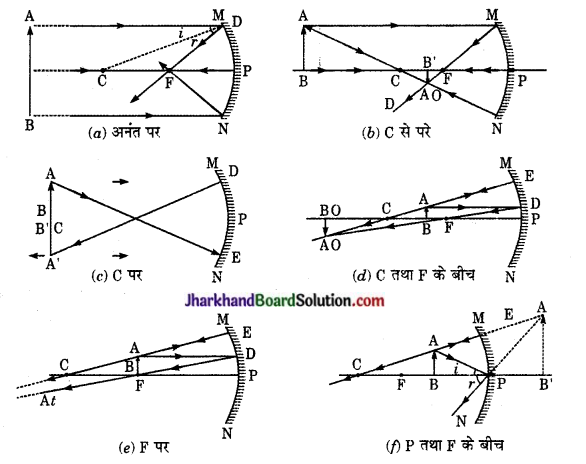
क्रिया-कलाप – 10.4
- (i) सारणी 10.1 में दर्शायी गई बिंब की प्रत्येक स्थिति के लिए स्वच्छ किरण आरेख खींचिए।
- (ii) प्रतिबिंब का स्थान निर्धारित करने के लिए आप पूर्व अनुच्छेद में वर्णित कोई दो किरणें ले सकते हैं।
- (iii) अपने चित्रों की तुलना ऊपर दिये गये चित्रों से कीजिए।
- (iv) प्रत्येक दशा में बनने वाले प्रतिबिंब की प्रकृति, स्थिति तथा आपेक्षिक साइज का वर्णन कीजिए।
- (v) अपने परिणामों को सुविधाजनक प्रारूप में सारणीबद्ध कीजिए।
संकेत-अवतल दर्पण द्वारा प्रतिबिंब का बनना दर्शाने के लिए किरण आरेख तथा प्रत्येक दशा में बनने वाले प्रतिबिम्ब की प्रकृति, स्थिति एवं आपेक्षिक साइज का वर्णन क्रियाकलाप -10.3 में दिया गया है।
क्रिया-कलाप- 10.5
- कोई उत्तल दर्पण लीजिए। इसे हाथ में पकड़िए।
- दूसरे हाथ में एक सीधी बड़ी पेंसिल पकड़िए।
क्रिया-कलाप के प्रश्नोत्तर
प्रश्न 1.
दर्पण में पेंसिल का प्रतिबिंब देखिए प्रतिबिंब सीधा है या उलटा? क्या यह छोटा है अथवा विवर्धित (बड़ा) है?
उत्तर:
सीधा तथा छोटा।
प्रश्न 2.
पेंसिल को धीरे-धीरे दर्पण से दूर ले जाइए। क्या प्रतिबिंब छोटा होता जाता है या बड़ा होता जाता है?
उत्तर:
छ्छेटा प्रतिबिम्ब बनता है।
प्रश्न 3.
क्रियाकलाप को सावधानीपूर्वक दोहराइए। बताइए कि जब बिंब को दर्पण से दूर ले जाते हैं तो प्रतिबिंब फोकस के निकट आता है अथवा उससे और दूर चला जाता है?
उत्तर:
प्रतिबिंब फोकस के निकट आता है। प्रतिबिंब फोकस के निकट बनता है।
क्रियाकलाप – 10.6
- समतल दर्पण में किसी दूरस्थ बिम्ब जैसे कोई दूरस्थ पेड़ का प्रतिबिम्ब देखिए।
क्रिया-कलाप के प्रश्नोत्तर
प्रश्न 1.
क्या आप पूर्ण लम्बाई (Full length) का प्रतिबिंब देख पाते हैं?
उत्तर:
पूर्ण लम्बाई का प्रतिबिम्ब नहीं देख पाते हैं।
प्रश्न 2.
विभिन्न साइज के समतल दर्पण लेकर प्रयोग दोहराइए। क्या आप दर्पण में बिंब का संपूर्ण प्रतिबिंब देख पाते हैं?
उत्तर:
नहीं।
प्रश्न 3.
इस क्रियाकलाप को अवतल दर्पण लेकर दोहराइए। क्या यह दर्पण बिंब की पूरी लंबाई का प्रतिबिंब बना पाता है?
उत्तर:
नहीं।
प्रश्न 4.
अब एक उत्तल दर्पण लेकर इस प्रयोग को दोहराइए। क्या आपको सफलता मिली? अपने प्रेक्षणों की कारण सहित व्याख्या कीजिए।
उत्तर:
हाँ, अब हमें बिंब का संपूर्ण प्रतिबिंब देख पाने में सफलता मिली। उत्तल दर्पण हमेशा छोटा, सीधा तथा आभासी प्रतिबिंब बनाता है। इसलिए दूर का बिंब उत्तल दर्पण में साफ देखा जा सकता है।
क्रियाकलाप- 10.7
- पानी से भरी एक बाल्टी की तली पर एक सिक्का रखिए।
क्रिया-कलाप के प्रश्नोत्तर
प्रश्न 1.
अपनी आँख को पानी के ऊपर किसी पार्श्व (Side) में रखकर सिक्के को एक बार में उठाने का प्रयत्न कीजिए। क्या आप सिक्का उठने में सफल हो पाते हैं?
उत्तर:
नहीं।
प्रश्न 2.
इस क्रियाकलाप को दोहराइए। आप इसे एक बार में करने में क्यों सफल नहीं हो पाए थे?
उत्तर:
क्योंकि अपवर्तन के कारण सिक्का अपने वास्तविक स्थान से ऊपर की ओर उठा हुआ प्रतीत होता है।

प्रश्न 3.
अपने मित्रों से इसे करने के लिए कहिए। उनके साथ अपने अनुभव की तुलना कीजिए।
उत्तर:
छात्र स्वयं करें।
क्रिया-कलाप – 10.8
- किसी मेज पर एक बड़ा उथला कटोरा रखकर उसकी तली में एक सिक्का रखिए।
- कटोरे से धीरे-धीरे दूर हटिए। जब सिक्का ठीक दिखाई देना बन्द हो जाए तो रूक जाइए।
- अपने मित्र से सिक्के को विक्षुब्ध किए बगैर कटोरे में पानी डालने को कहिए।
क्रिया-कलाप के प्रश्नोत्तर
प्रश्न 1.
अपनी स्थिति से सिक्के को देखते रहिए। क्या सिक्का उसी स्थिति से पुनः दिखाई देने लगता है? यह कैसे संभव हो पाता है?
उत्तर:
कटोरे में पानी डालने पर सिक्का पुन: उसी स्थिति में दिखाई देने लगता है क्योंकि अपवर्तन के कारण सिक्के की स्थिति उसकी वास्तविक स्थिति से उठी हुई प्रतीत होती है, इसलिए सिक्का दिखाई देने लगता है।
क्रिया-कलाप-10.9
- मेज पर रखे एक सफेद कागज की शीट पर एक मोटी सीधी रेखा खींचिए।
- इस रेखा के ऊपर एक काँच का स्लैब इस प्रकार रखिए कि इसकी एक कोर इस रेखा से कोई कोण बनाएँ।
क्रिया-कलाप के प्रश्नोत्तर
प्रश्न 1.
स्लैब के नीचे आए रेखा के भाग को पार्श्व (side) से देखिए आप क्या देखते हैं? क्या काँच के स्लैब के नीचे की रेखा कोरों (edges) के पास मुड़ी हुई प्रतीत होती है?
उत्तर:
हाँ, ऐसा रोशनी के अपवर्तन के कारण हो रहा है।
प्रश्न 2.
अब काँच के स्लैब को इस प्रकार रखिए कि यह रेखा के अभिलंबवत हो। अब आप क्या देखते हैं? क्या काँच के स्लैब के नीचे रेखा का भाग मुड़ा हुआ प्रतीत होता है?
उत्तर:
अब, रेखा सीधी है और मुड़ी हुई प्रतीत नहीं हो रही क्योंकि रोशनी की सीधी किरण में अपवर्तन नहीं होता है।
प्रश्न 3.
रेखा को काँच के स्लैब के ऊपर से देखिए। क्या स्लैब के नीचे रेखा का भाग उठा हुआ प्रतीत होता है? ऐसा क्यों होता है?
उत्तर:
हाँ, ऐसा अपवर्तन के कारण होता है। इसकी वजह से बिंब की स्थिति वास्तविक स्थिति से उठी हुई दिखाई देती है।
क्रिया-कलाप – 10.10
- एक ड्राइंग बोर्ड पर सफेद कागज की एक शीट, ड्राइंग पिनों की सहायता से लगाइए।
- शीट के ऊपर बीच में काँच का एक आयताकार स्लैब रखिए।
- पेंसिल से स्लैब की रूपरेखा खींचिए। इस रूपरेखा का नाम ABCD रखते हैं।
- चार एकसमान ऑलपिन लीजिए।
- दो पिर्ने, मान लीजिए E तथा F ऊर्ध्वाधरत: इस प्रकार लगाइए कि पिनों को मिलाने वाली रेखा कोर AB से कोई कोण बनाती हुई हो।
- पिन E तथा F के प्रतिबिंबों को विपरीत फलक से देखिए। दूसरी दो पिनों, माना G तथा H, को इस प्रकार लगाइए कि ये पिर्ने एवं E तथा F के प्रतिबिंब एक सीधी रेखा पर स्थित हों।
- पिनों तथा स्लैब को हटाइए।
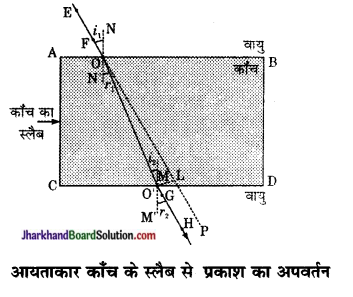
- पिनों E तथा F की नोकों (tip) की स्थितियों को मिलाइए तथा इस रेखा को AB तब बढ़ाइए। मान लीजिए EF, AB से बिंदु पर मिलती है। इसी प्रकार पिनों G तथा H की नोकों की स्थितियों को मिलाइए तथा इस रेखा को कोर CD तक बढ़ाइए। मान लीजिए HG, CD से O’ पर मिलती है।
- O तथा O’ को मिलाइए EF को भी P तक बढ़ाइए, जैसा कि चित्र में बिंदुकित रेखा द्वारा दर्शाया गया है।
क्रिया-कलाप के प्रश्नोत्तर
प्रश्न 1.
क्या होता है जब प्रकाश की किरणें काँच के स्लैब में प्रवेश करती हैं?
उत्तर:
प्रकाश का अपवर्तन होता है और यह अभिलंब की तरफ मुड़ जाती है। ऐसा प्रकाश की चाल काँच के स्लैब में अपेक्षाकृत कम होने के कारण होता है।
प्रश्न 2.
क्या होता है जब प्रकाश की किरणें स्लैब से बाहर निकलती हैं?
उत्तर:
वायु में प्रकाश की चाल अधिक होती है अतः प्रकाश अभिलंब से दूर मुड़ जाता है।
प्रश्न 3.
निर्गत किरण तथा आपतित किरण के बीच की लंबवत दूरी को क्या कहते हैं?
उत्तर:
पाश्विक विस्थापन।
प्रश्न 4.
आपतित कोण तथा निर्गत कोण के बीच क्या संबंध होता है अगर आपतित किरण तथा निर्गत किरण दोनों का माध्यम समान हो ?
उत्तर:
आपतित कोण = निर्गत कोण।
क्रिया-कलाप – 10.11
चेतावनी- इस क्रियाकलाप को करते समय अथवा अन्यथा भी सूर्य की ओर सीधे या लेंस से न देखें। यदि आप रेसा करेंगे तो आपकी आँखों को क्षति हो सकती है
- एक उत्तल लेंस को अपने हाथ में पकड़िए। इसे की ओर निर्दिष्ट कीजिए।
- सूर्य के प्रकाश को एक कागज की शीट पर फोकसित कीजिए। सूर्य का एक तीक्ष्ण चमकदार प्रतिबिंब प्राप्त कीजिए।
क्रिया-कलाप के प्रश्नोत्तर
प्रश्न 1.
कागज तथा लेंस को कुछ समय के लिए उसी स्थिति में पकड़े रखिए। कागज को देखते रहिए। क्या होता है? ऐसा क्यों होता है?
उत्तर:
कागज पूरी तरह जल गया। लेंस की मदद से सूर्य के प्रकाश को एक बिंदु पर फोकसित किया गया। सूर्य की किरणों में ऊर्जा होती है जिससे कि ऊष्मा उत्पन्न हुई और कागज जल गया।
क्रिया-कलाप – 10.12
- एक उत्तल लेंस लीजिए। क्रियाकलाप 10.11 में वर्णित विधि द्वारा इसकी सन्निकट फोकस दूरी ज्ञात कीजिए।
- एक लंबी मेज पर चॉक का प्रयोग करके पाँच समांतर सीधी रेखाएँ इस प्रकार खींचिए कि किन्हीं दो उत्तरोतर रेखाओं के बीच की दूरी लेंस की फोकस दूरी के बराबर हो।
- लेंस को एक लेंस स्टैंड पर लगाइए। इसे मध्य रेखा पर इस प्रकार रखिए कि लेंस का प्रकाशिक केन्द्र इस रेखा पर स्थिति हो।
- लेंस के दोनों ओर दो रेखाएँ क्रमशः लेंस के स तथा 2F के तदनुरूपी होंगी। इन्हें उचित अक्षरों द्वारा अंति कीजिए, जैसे क्रमश: 2F1, F1, F2 तथा 2F2।
- एक जलती हुई मोमबत्ती को बाईं ओर, 2 F1 से काफी दूर रखिए। लेंस के विपरीत दिशा में रखे एक परदे पर इसका स्पष्ट एवं तीक्ष्ण प्रतिबिंब बनाइए।
- प्रतिबिंब की प्रकृति, स्थिति तथा आपेक्षिक साइज नोट कीजिए।
- इस क्रियाकलाप में बिंब को 2F1 से थोड़ा दूर, F1 तथा 2F1 के बीच, F1 पर तथा F1 और 0 के बीच रखकर दोहराइए। अपने प्रेक्षणों को नोट कीजिए तथा सारणीबद्ध कीजिए।
सारणी में बिंब की विभिन्न स्थितियों के लिए उत्तल लेंस द्वारा बने प्रतिबिंब की प्रकृति, स्थिति तथा आपेक्षिक साइज सारणी में दर्शाई गयी है।
| बिंब की स्थिति | प्रतिबिंब की स्थिति | प्रतिबिंब का आपेक्षिक साइज | प्रतिबिंब की प्रकृति |
| अनंत पर | फोकस F2 पर | अत्यधिक छोटा, | वास्तविक तथा उलटा |
| 2F1 से परे | F2तथा 2F2 के बीच | बिन्दु आकार | वास्तविक तथा उलटा |
| 2F1 पर | 2F2 पर | छोटा | वास्तविक तथा उलटा |
| F1 तथा 2F1 के बीच | 2F2 से परे | रापान साइज | वास्तविक तथा उलटा |
| फोकस F1 पर | अनंत पर | नक़ (लिर्धर्धित | वास्तविक तथा उलटा |
| फोकस F1 तथा प्रकाशिक केन्द्र O के बीच | जिस ओर बिंब है | असीमित चप थे बड़ा | आभासी तथा सीधा |
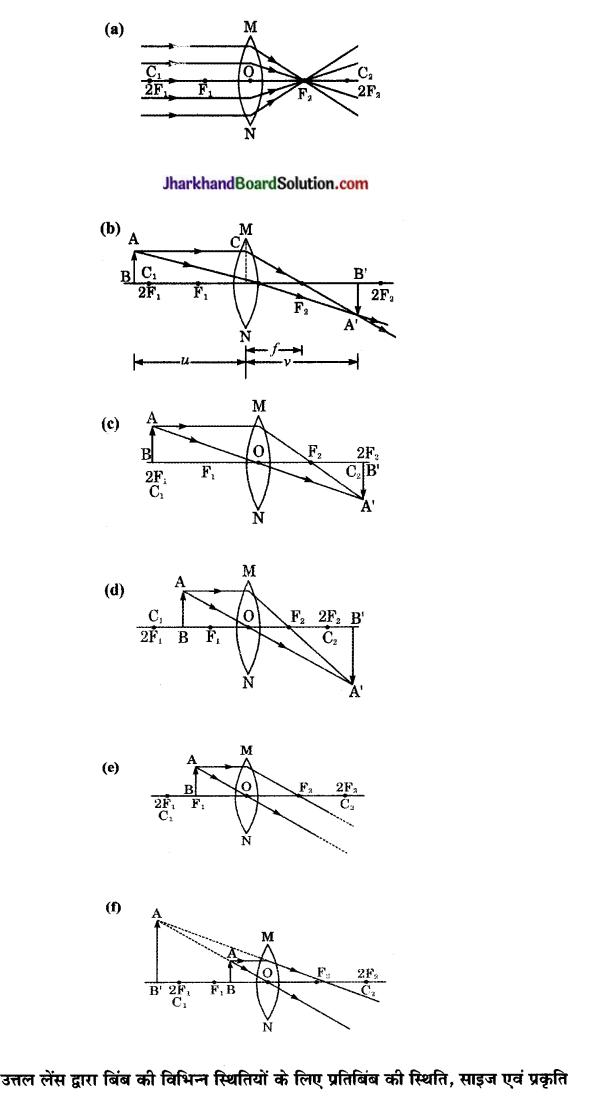
क्रिया-कलाप – 10.13
- एक अवतल लेंस लीजिए। इसे एक लेंस स्टैंड पर रखिए।
- लेंस के एक ओर एक जलती हुई, मोमबत्ती को रखिए।
- लेंस के दूसरी ओर से प्रतिबिम्ब का प्रेक्षण कीजिए। प्रतिबिंब को यदि संभव हो तो परदे पर प्राप्त करने का प्रयत्न कीजिए। यदि ऐसा संभव न हो तो प्रतिबिंब को लेंस में से सीधे ही देखिए।
क्रिया-कलाप के प्रश्नोत्तर
प्रश्न 1.
प्रतिबिंब की प्रकृति, आपेक्षिक आकार तथा सन्निकट स्थिति नोट कीजिए।
उत्तर:
प्रतिबिंब फोकस F1 तथा प्रकाशीय केन्द्र O के मध्य बना है। इसका आपेक्षिक साइज छोटा, आभासी तथा सीधा है।
प्रश्न 2.
मोमबत्ती को लेंस से दूर ले जाइए। प्रतिबिंब के साइज में परिवर्तन नोट कीजिए। जब मोमबत्ती को लेंस से बहुत दूर रखा जाता है तो प्रतिबिंब के साइज पर क्या प्रभाव पड़ता है?
उत्तर:
प्रतिबिंब छोटा हो जाता है।
![]()
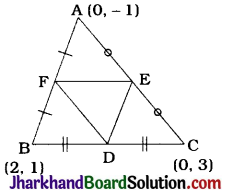
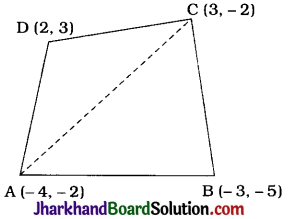
![]()
